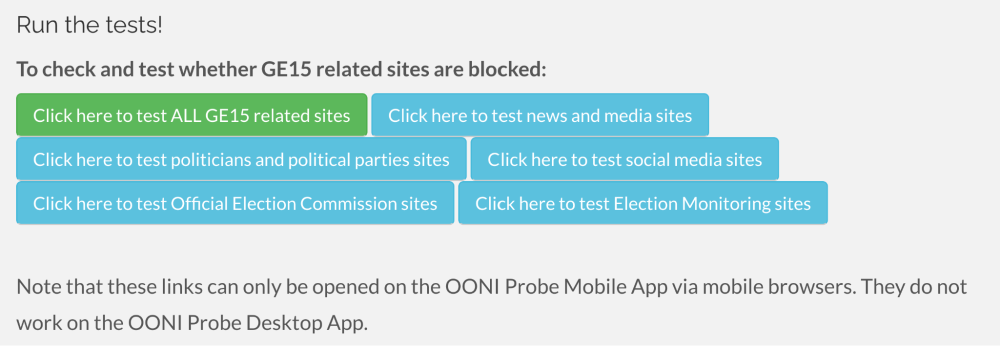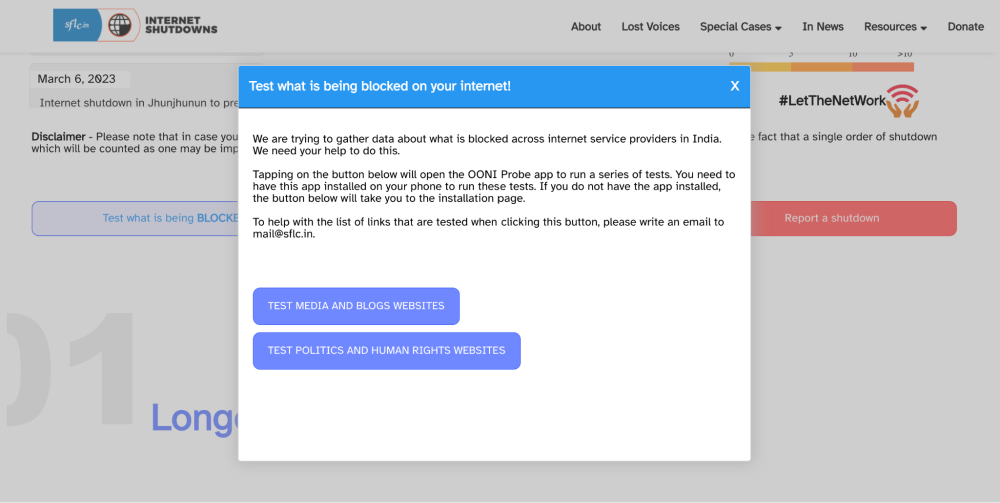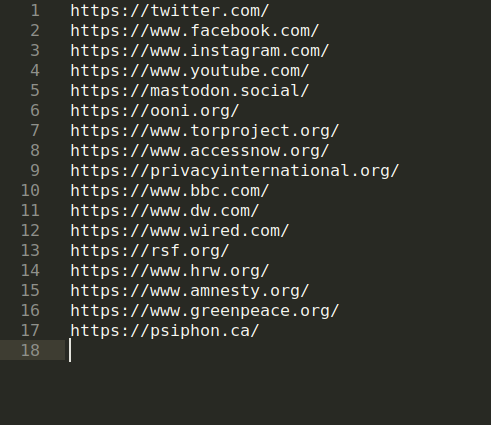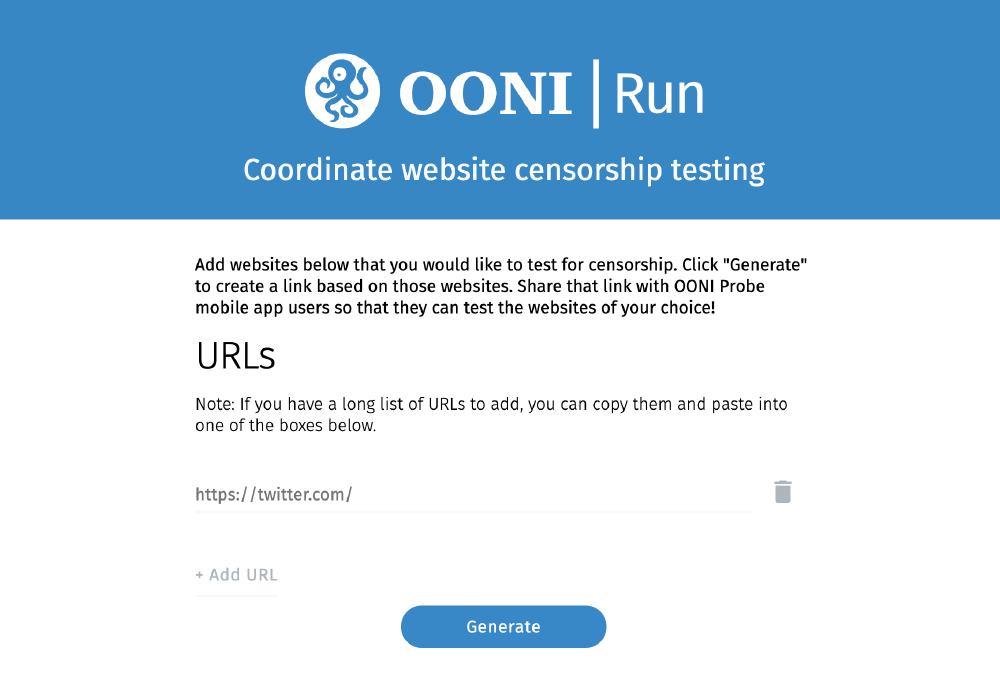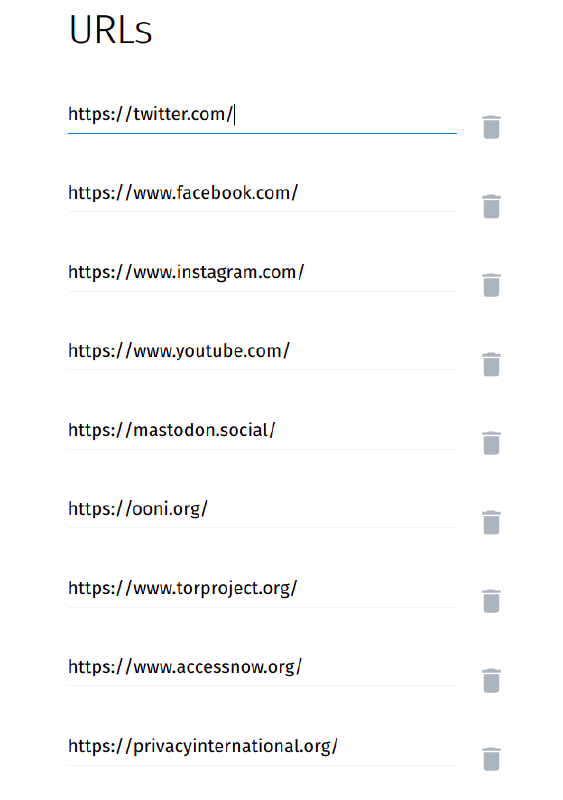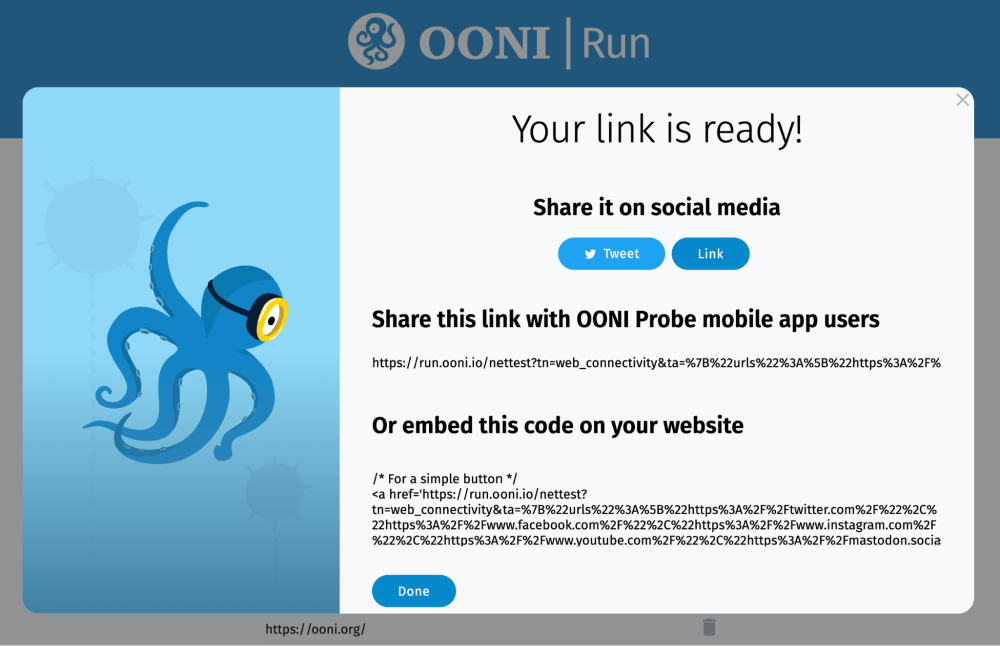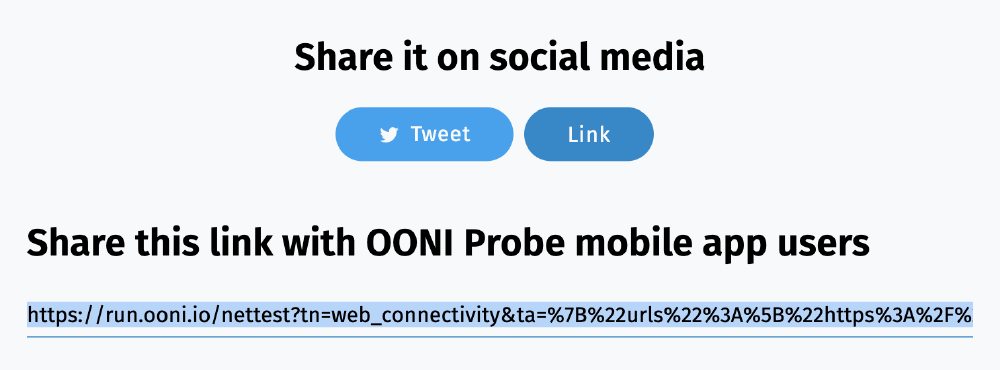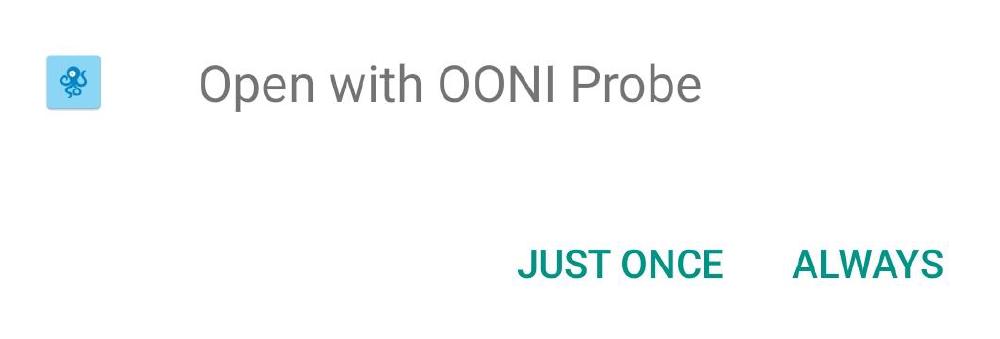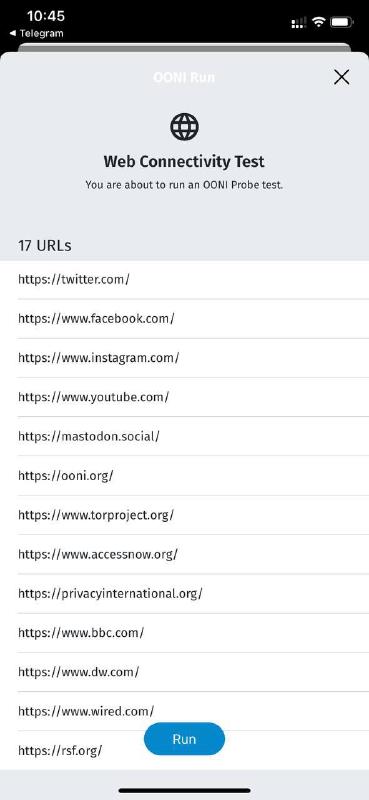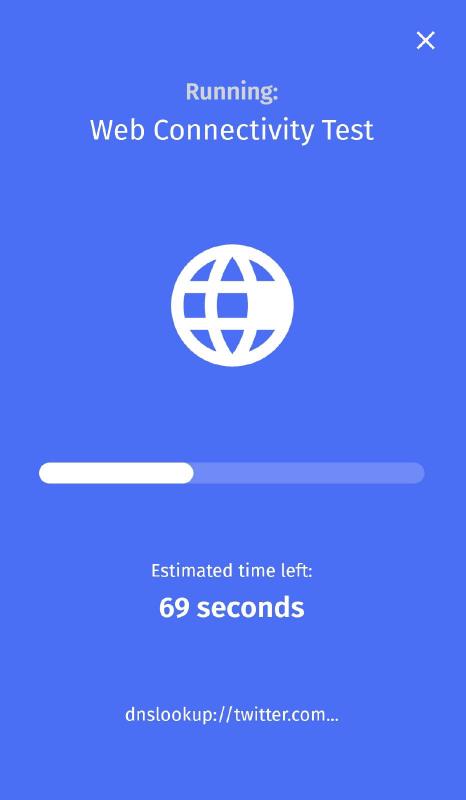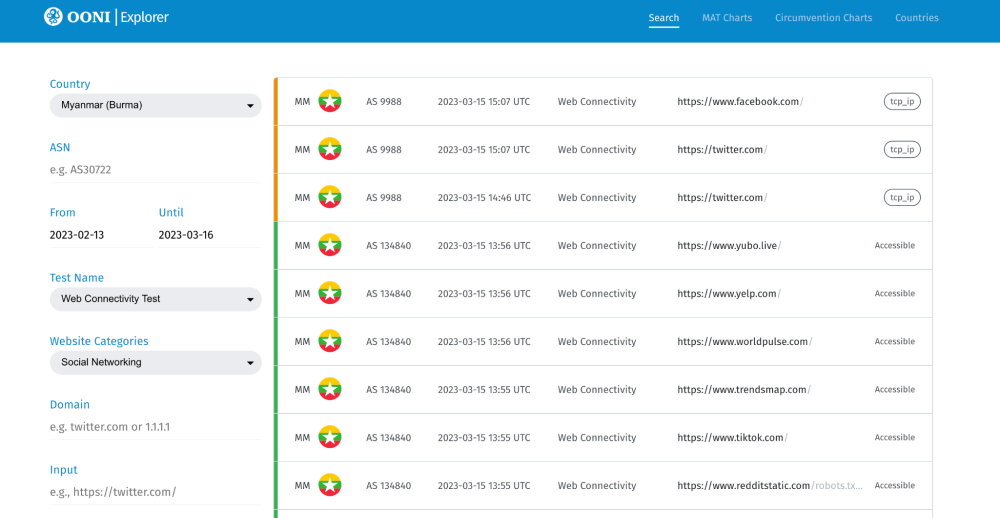Coordinating OONI censorship measurement campaigns
Last updated: 21st March 2023
Internet censorship around the world often emerges during political events, such as elections or protests. The abrupt emergence of new blocks requires rapid response in terms of measurement, particularly if the blocks are short-lived. Such measurement can help with the collection of data that can potentially serve as evidence of internet censorship, supporting the efforts of journalists, researchers, and human rights defenders challenging the blocks.
Detecting sudden or expected blocks can be achieved through community coordination on censorship measurement.
This documentation explains how you can organize OONI censorship measurement campaigns with your communities.
What are OONI censorship measurement campaigns?
OONI censorship measurement campaigns are community-coordinated efforts aimed at measuring the blocking of specific websites through the use of OONI Probe.
Specifically, community members use the OONI Run platform to generate mobile deep links based on the specific website(s) that they want to measure for censorship. These links are shared with their community of volunteers (who are OONI Probe mobile app users) in their country, region, or elsewhere in the world. Their community uses these links to test the website(s), contributing measurements that are published as open data in real-time.
Generally, the goal of OONI censorship measurement campaigns is to rapidly collect (and publish) data in response to emergent censorship events.
Community members often run such campaigns leading up to and during an election, or in response to emergent new blocks during protests or other political events. Sometimes, researchers coordinate with communities of OONI Probe volunteers for the testing of their custom lists of websites.
Why run OONI censorship measurement campaigns?
Censorship events tend to emerge during political events, such as elections or protests. Such blocks are often short-lived (for example, limited to election day), enabling governments to potentially seek plausible deniability.
Rapidly measuring such blocks – and collecting data that can serve as evidence – is therefore necessary.
However, if you run OONI Probe, you are only performing tests on the network that you’re connected to. This means that you cannot measure censorship implemented on different networks or in different countries. If you use a VPN or VPS for remote testing, your measurements will not be as accurate as if run directly inside the intended country.
By running an OONI censorship measurement campaign, you can coordinate with other OONI Probe users (who are in the country or connected to the networks where the blocks are reported or suspected) to ensure that specific websites are rapidly measured, and that relevant data (which may serve as evidence) is openly published in real-time. Such data can support research and advocacy efforts investigating the blocks.
Examples of OONI censorship measurement campaigns
Over the years, internet freedom community members have coordinated OONI censorship measurement campaigns in support of their research and advocacy efforts.
For example, Sinar Project coordinated an OONI censorship measurement campaign in Malaysia to encourage the testing of election-related websites during the country’s 2022 general election. As part of this, they published a Call to Action with OONI Probe testing instructions and the following OONI Run widgets embedded into their website.
Image: Call to Action for OONI Probe testing of election-related websites during Malaysia’s 2022 general election (source: Sinar Project).
India’s Software Freedom Law Centre (SFLC.in) embedded OONI Run widgets into their India Internet Shutdown Tracker project website, encouraging long-term OONI Probe testing of news media, blogs, human rights, and political websites in India.
Image: Call to Action for OONI Probe testing of news media, blogs, human rights, and political websites in India (source: SFLC.in).
Over the years, Conexión Segura y Libre coordinated with OONI Probe volunteers in different regions of Venezuela to measure (and respond to) temporary website blocks which emerged in correlation with political events. Human rights advocates from the global #KeepItOn campaign coordinated OONI censorship measurement campaigns leading up to and during political events (such as elections and protests), using OONI data to support their advocacy efforts in response to emergent censorship events.
Community members have also run OONI censorship measurement campaigns for research purposes. Digital Security Lab Ukraine, for example, coordinated with OONI Probe volunteers in different regions of Ukraine to examine how internet censorship differs from region to region (and network to network) in the country. OTF Information Controls research fellows, Igor Valentovitch and Ksenia Ermoshina, investigated and compared internet censorship in Russia and Crimea during Russia’s 2018 presidential election by coordinating with OONI Probe communities for the testing of their custom lists of websites.
How to run an OONI censorship measurement campaign
To organize your own OONI censorship measurement campaign:
Step 1. Determine the question(s) that you would like to investigate through your campaign.
Such questions help inform the timing and location of the campaign, the types of websites that would need to be tested, and other relevant factors that will help inform the design of your campaign.
For example, if you’re concerned about new censorship events emerging during Cambodia’s 2023 general election, a relevant question could be:
“Are election-monitoring and political opposition websites accessible in Cambodia during the country’s 2023 general election?”
Based on the above question, you would need to:
- Engage OONI Probe users in Cambodia for website testing:
- You can encourage them to take the online OONI training course;
- Please communicate that censorship measurement is potentially risky;
- Determine which election-monitoring and political opposition websites you would like OONI Probe users in Cambodia to test;
- Ensure that the testing is carried out during Cambodia’s 2023 elections (July 2023).
Note: Internet censorship is often limited to specific networks or regions within a country. You would therefore (ideally) engage OONI Probe users connected to as many networks and in as many regions in a country as possible. Depending on where internet censorship is reported, you may need to coordinate with people to run OONI Probe in those regions.
When determining the question(s) that will inform your campaign, it’s also worth determining your campaign goals (and relevant outputs, such as the publication of research).
Step 2. Determine which website(s) you would like to test for censorship.
This step may require some research to determine the specific URLs that you would like to measure for censorship. For example, if you’re interested in monitoring political opposition websites in Cambodia, you may need to start off by carrying out some desk research to identify those sites. It may also be worth reaching out to local experts, asking for website testing recommendations.
Step 3. Save yourlist of websites in a text editor, where each URL is in a separate line. You do not need to separate URLs by commas or in any other way.
Important: Please ensure that each URL is typed correctly. If it is mis-typed, OONI Probe will not test the intended website and this will potentially lead to inaccurate test results.
A few things to keep in mind:
- Is the website on HTTP or HTTPS? If the latter, please add an extra
safterhttp. - Does the domain include
www? If so, please include it. - If the website is on HTTPS (e.g
https://www.hrw.org/), you don’t need to specify a webpage (e.ghttps://www.hrw.org/publications), since ISPs usually cannot limit blocking to a specific webpage when it’s hosted on HTTPS. Rather, they would have to block access to the entire website.
To ensure that each URL is typed accurately, please copy-paste it from a browser.
Optional, but encouraged: If some of the websites that you’re using for your measurement campaign are relevant for country-wide or worldwide testing, please propose them for the lists of websites ("test lists") tested by all OONI Probe users. You can do so through our Test Lists Editor.
Step 4. Copy your list of URLs (from your text editor).
Step 5. Visit the OONI Run website: https://run.ooni.org/
Step 6. Paste your list of URLs into the first URL slot of the OONI Run page.
You should now see that all of your URLs have populated each URL row in the OONI Run page.
If you notice any empty rows (or otherwise misformatted URLs), please delete them by clicking on the deletion icon or edit them by clicking on the URL field.
Step 7. Click the Generate button at the end of your list.
You will now see the following pop-up window.
Note: If you have a long list of websites (resulting in the generated link being very long), we recommend using the widget code generated through the pop-up window to embed a widget into your website (for the testing of your list of websites). Learn more through our OONI Run user guide. You can also refer to the widgets that we have embedded into the OONI website.
Step 8. Copy the generated mobile deep link either by:
- Clicking the link under “Share this link with OONI Probe mobile app users”, pressing Control+A to select the whole link, and subsequently pressing Control + C to copy it; or
- Right-clicking the Link button and selecting “Copy link address”.
Step 9. Share the copied link with OONI Probe mobile app users in the country where you would like your list of websites to get tested (it’s not currently possible to use these links with the OONI Probe desktop app). Alternatively, share the link on Twitter by clicking the Tweet button.
Important: When engaging people with the use of OONI Probe, please communicate that censorship measurement can potentially be risky. Participants should be aware of potential risks and provide consent.
When your communities receive the link, they should open it with the OONI Probe mobile app (not with a web browser).
They will then see your list of websites in their OONI Probe mobile app.
If they agree to test your list of websites, they can do so by tapping Run.
Important: Please encourage your community of OONI Probe testers to perform testing as many times as possible on multiple networks based on the shared link (the more results, the greater the evidence of potential censorship). If there are reports that some websites are not accessible on different networks or in different regions in the country, please share the link with OONI Probe users there too.
Once the testing has completed, OONI Probe users will have immediate access to the test results through their OONI Probe mobile app, which they can share with you.
All OONI Probe test results will automatically get published on OONI Explorer and on the OONI API in near real-time.
Step 10. Find the test results on OONI Explorer: https://explorer.ooni.org/search
Learn how to use OONI Explorer to find measurements relevant to your campaign through our user guide.
If you have any questions or need OONI data analysis support, please feel encouraged to contact the OONI team.
If you publish research based on your campaign, we’d love to learn about it!

